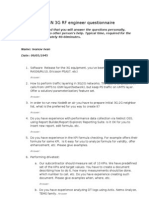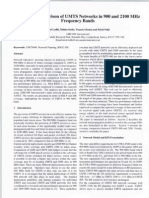Atoll 3.3.2 Neighbours
Atoll 3.3.2 Neighbours
Uploaded by
Ohiwei OsawemenCopyright:
Available Formats
Atoll 3.3.2 Neighbours
Atoll 3.3.2 Neighbours
Uploaded by
Ohiwei OsawemenCopyright
Available Formats
Share this document
Did you find this document useful?
Is this content inappropriate?
Copyright:
Available Formats
Atoll 3.3.2 Neighbours
Atoll 3.3.2 Neighbours
Uploaded by
Ohiwei OsawemenCopyright:
Available Formats
Neighbour Management
Atoll 3.3.2
Confidential – Do not share without prior permission
Neighbour Features in Atoll
1. Definitions
2. Requirements
3. Importing Neighbours
4. Planning Intra-technology Neighbours
5. Planning Inter-technology Neighbours
6. Layers in Neighbours Planning
7. Modifying and Displaying Neighbour Relations
8. Exporting Neighbour Relations
Confidential – © Forsk 2017 | 2
Definitions
Reference cell
The cell to which you are allocating neighbours
Possible neighbours
The cells that fulfil the requirements to be neighbours
Intra-technology neighbours
The cells defined as neighbours that use the same technology as the reference cell
• E.g., UMTS-UMTS, GSM-GSM, LTE-LTE
Inter-technology neighbours
The cells defined as neighbours that use a technology other than the reference cell technology
• E.g., UMTS-GSM, UMTS-LTE, GSM-LTE
Confidential – © Forsk 2017 | 3
Requirements
Requirements for all transmitters to be allocated
They must be active
They satisfy the filter criteria applied to the “Transmitters” folder
They are located inside the focus zone, if existing
• If there is no focus zone defined in your document, Atoll takes into account the computation zone, if existing
They must have an antenna otherwise they can no longer be considered as a candidate neighbour.
They belong to the folder on which allocation has been executed
• This folder can be either the “Transmitters” folder or a group of transmitters or even a single transmitter
No coverage prediction is needed to perform an automatic neighbour allocation
When starting a neighbour allocation, Atoll automatically calculates the path loss matrices if not
found
Confidential – © Forsk 2017 | 4
Neighbour Features in Atoll
1. Definitions
2. Requirements
3. Importing Neighbours
4. Planning Intra-technology Neighbours
5. Planning Inter-technology Neighbours
6. Layers in Neighbours Planning
7. Modifying and Displaying Neighbour Relations
8. Exporting Neighbour Relations
Confidential – © Forsk 2017 | 5
Importing Neighbours (1/2)
Possibility to copy/paste or to import a list of neighbours
Prerequisites
A text file with at least 2 columns
• Name of the reference cells
• Name of neighbour cells
Confidential – © Forsk 2017 | 6
Importing Neighbours (2/2)
Comparison of neighbours
in the ATL file with the
imported neighbour list
Add: add new neighbours
Update and add: add new neighbours and update
existing neighbours
Reset and add: update neighbours for the reference cells
available in the import file
Confidential – © Forsk 2017 | 7
Neighbour Features in Atoll
1. Definitions
2. Requirements
3. Importing Neighbours
4. Planning Intra-technology Neighbours
5. Planning Inter-technology Neighbours
6. Layers in Neighbours Planning
7. Modifying and Displaying Neighbour Relations
8. Exporting Neighbour Relations
Confidential – © Forsk 2017 | 8
Planning Intra-technology Neighbours (1/15)
Neighbourhood constraints can be considered during the automatic neighbour allocation
Some neighbour relations can be defined as forced or forbidden
• Such relations are referred to as “Exceptional Pairs”
List of neighbour relations you may force or
forbid
Confidential – © Forsk 2017 | 9
Planning Intra-technology Neighbours (2/15)
Allocation parameters
Maximum number of neighbours
• Global value for all cells or value specified for each cell
• At the end of the automatic allocation process, Atoll lists all potential neighbours and ranks them by importance
to eliminate some of them from the neighbour list if the maximum number of neighbours to be allocated to
each transmitter is exceeded
Ex: Let’s consider the case for which there are 15 candidate neighbours and the maximum number of
neighbours to be allocated to the reference transmitter is 8. Among these 15 candidate neighbours, only 8
(having the highest importance) will be allocated to the reference transmitter
Maximum inter-site distance
• If the distance between the reference transmitter and the candidate neighbour is greater than this value, then
the candidate neighbour is discarded
• Atoll takes into account the real inter-site distance and azimuths of antennas in order to calculate the effective
inter-transmitter distance
Allocation strategy based on cells overlapping
Confidential – © Forsk 2017 | 10
Planning Intra-technology Neighbours (3/15)
Repeater and remote antenna information can be displayed in the Neighbours table
When repeaters and remote antennas are considered in the inter-site calculations
(RepeaterInterSiteDistanceInAlloc=1 in the [Neighbours] section)
By adding custom fields to the Neighbours table (“CF_REP_TRANSMITTER” – Text(50),
“CF_REP_NEIGHBOUR” – Text(50), “CF_REP_DISTANCE” - Double)
Calculated during automatic neighbour allocation
Confidential – © Forsk 2017 | 11
Planning Intra-technology Neighbours (4/15)
GSM technology
Coverage
conditions
Overlapping criterion
(see next slide)
Allocation
constraints
Do not select the option if
you want to keep existing Start allocation
neighbours
Confidential – © Forsk 2017 | 12
Planning Intra-technology Neighbours (5/15)
GSM technology
Minimum signal level which must be
provided by reference cell A and
potential neighbour cell B
Enter Handover start and Handover
stop to manage mobility in
Neighbours Allocation
Confidential – © Forsk 2017 | 13
Planning Intra-technology Neighbours (6/15)
GSM technology
Overlapping criterion
• “% min covered area” is defined by the formula (SA ∩ SB) / SA where:
• SA is the coverage area of cell A restricted by HO start and HO end margins
• SB is the best server area of cell B
Best server area of cell B
Best server area of cell A (Candidate)
(Reference cell) B
Best signal level for A - HO end
Cell edge of A defined by Best signal level for A - HO start
“Min BCCH signal level”
Confidential – © Forsk 2017 | 14
Planning Intra-technology Neighbours (7/15)
UMTS technology
Intra-carrier neighbours: neighbours which perform handover using the same carrier
Inter-carrier neighbours: neighbours which perform handover using a different carrier
Coverage conditions
Overlapping criterion
Allocation constraints
Do not select the option if you want
to keep existing neighbours
Start allocation
Confidential – © Forsk 2017 | 15
Planning Intra-technology Neighbours (8/15)
UMTS technology
Minimum signal level which must be
provided by reference cell A and
potential neighbour cell B
Atoll should use a Global value
(% Pmax) of the downlink load
for all the cells, or the downlink
loads Defined per cell
Enter the minimum Ec⁄Io which must be Enter the maximum difference of Ec⁄I0 between
provided by reference cell A in an overlapping reference cell A and potential neighbour cell B in
area. the overlapping area
Confidential – © Forsk 2017 | 16
Planning Intra-technology Neighbours (9/15)
UMTS technology – intra-carrier neighbours
Overlapping criterion
• “% min covered area” is defined by the formula (SA ∩ SB) / SA where:
• SA is the best server area of cell A (first cell in the active set)
• SB is the area where cell B can enter the active set of cell A
Best server area of cell B
(Candidate)
Best server area of cell A
(Reference cell) B
SA ∩ SB , area where:
Ec/Io(B) ≥ Ec/Io(A) – Ec/Io margin(A)
Cell edge of A defined by
“Min Ec/Io”
Confidential – © Forsk 2017 | 17
Planning Intra-technology Neighbours (10/15)
UMTS technology – inter-carrier neighbours
Overlapping criterion (carrier saturation)
• “% min covered area” is defined by the formula (SA ∩ SB) / SB where:
• SA is the best server area (on carrier 1) + handoff area of cell A
• SB is the best server area of cell B (on carrier 2)
Best server area of cell B
(Carrier 2 - candidate)
Best server area of cell A
(Carrier 1 – reference cell) B
Cell edge of A defined by
“Min Ec/Io” Best Ec/Io for A - Ec/Io margin
Confidential – © Forsk 2017 | 18
Planning Intra-technology Neighbours (11/15)
UMTS technology – inter-carrier neighbours
Overlapping criterion (at the edge of carrier coverage)
• % min covered area is defined by the formula (SA ∩ SB) / SB where:
• SA is the ring defined by the coverage area of A + Ec/Io margin, and the best server area of A (on carrier 1)
• SB is the best server area of cell B (on carrier 2)
Best server area of cell B
(Carrier 2 - candidate)
A
Minimum Ec/Io for A and
best server area of cell A
(carrier 1 – reference cell)
Minimum Ec/Io for A +
Ec/Io margin
Confidential – © Forsk 2017 | 19
Planning Intra-technology Neighbours (12/15)
LTE technology
Coverage conditions
Overlapping criterion
Allocation constraints
Do not select the option if you want
to keep existing neighbours
Start allocation
Confidential – © Forsk 2017 | 20
Planning Intra-technology Neighbours (13/15)
LTE technology
Minimum signal level which must be
provided by reference cell A and
potential neighbour cell B
Enter Handover start and
Handover stop to manage
mobility in Neighbours
Allocation
Confidential – © Forsk 2017 | 21
Planning Intra-technology Neighbours (14/15)
LTE technology
Overlapping criterion
• “% min covered area” is defined by the formula (SA ∩ SB) / SA where:
• SA is the coverage area defined by the RSRP margin (orange ring below)
• SB is the best server area of cell B
Best reference signal
level area of cell B
Cell B (Candidate)
Best reference signal
level area of cell A Best server area
(Reference cell)
Cell A
Best server area
RSRP margin
Cell edge of A defined
by “Min RSRP”
Confidential – © Forsk 2017 | 22
Planning Intra-technology Neighbours (15/15)
Allocation results
Sorted list of neighbours with allocation reasons and importance value ϵ [0-1]
Allocation results
Sort and
filtering tools
Commit selected
neighbours only
Summary report listing existing,
new and removed neighbours
Confidential – © Forsk 2017 | 23
Neighbour Features in Atoll
1. Definitions
2. Requirements
3. Importing Neighbours
4. Planning Intra-technology Neighbours
5. Planning Inter-technology Neighbours
6. Layers in Neighbours Planning
7. Modifying and Displaying Neighbour Relations
8. Exporting Neighbour Relations
Confidential – © Forsk 2017 | 24
Planning Inter-technology Neighbours (1/5)
Possibility to define neighbourhood constraints to be considered during the automatic
neighbour allocation (similar to intra-technology neighbours)
List of neighbour relations you may force or
forbid
Confidential – © Forsk 2017 | 25
Planning Inter-technology Neighbours (2/5)
Allocation parameters
Maximum number of neighbours
• Global value for all cells or value specified for each cell
• Similar to the intra-technology neighbours
Maximum inter-site distance
• Similar to the intra-technology neighbours
2 allocation strategies
• Based on distance
• Based on overlapping between coverage areas
Confidential – © Forsk 2017 | 26
Planning Inter-technology Neighbours (3/5)
Inter-technology neighbour automatic allocation
Coverage conditions
Overlapping criterion
Allocation constraints
Do not select the option if you want to
keep existing neighbours
Start allocation
Confidential – © Forsk 2017 | 27
Planning Inter-technology Neighbours (4/5)
Coverage conditions
GSM
• BCCH signal level
• Area where the BCCH signal level of the cell is either the highest one or within a margin of the highest one
UMTS
• Pilot quality (Ec/I0)
• Area where the cell is either the best server in terms of pilot quality or a cell of the active set
LTE
• Reference signal level
• Area where the reference signal level of the cell is either the highest one or within a margin of the highest one
Confidential – © Forsk 2017 | 28
Planning Inter-technology Neighbours (5/5)
Allocation results Allocation results Sort and filtering tools
Commit selected
Summary neighbours only
report listing
existing, new
and removed
neighbours
Confidential – © Forsk 2017 | 29
Neighbour Features in Atoll
1. Definitions
2. Requirements
3. Importing Neighbours
4. Planning Intra-technology Neighbours
5. Planning Inter-technology Neighbours
6. Layers in Neighbours Planning
7. Modifying and Displaying Neighbour Relations
8. Exporting Neighbour Relations
Confidential – © Forsk 2017 | 30
Layers in Neighbour Planning
Cross layer adjacency taken into account when determining intra-carrier and inter-carrier
neighbour of cells and importance
Atoll calculates a prediction for each layer on the considered carrier
The cause Adjacent layer will be applied for all pixels covered by different layers
Confidential – © Forsk 2017 | 31
Layers in Neighbour Planning
The LTE intra‐technology automatic neighbour allocation algorithm, and the importance
calculation function, now take into account the per‐cell handover margin values as well
as the cell individual offsets.
The cause Adjacent layer will be applied for all pixels covered by different layers
Confidential – © Forsk 2017 | 32
Neighbour Features in Atoll
1. Definitions
2. Requirements
3. Importing Neighbours
4. Planning Intra-technology Neighbours
5. Planning Inter-technology Neighbours
6. Layers in Neighbours Planning
7. Modifying and Displaying Neighbour Relations
8. Exporting Neighbour Relations
Confidential – © Forsk 2017 | 33
Modifying and Displaying Neighbour Relations (1/4)
Possibility to add/remove neighbour relations
Directly on the map using the [ctrl] and [shift] keys
Through the transmitters properties dialogue
Neighbour list of CHIC400_GSM4
List of transmitters within a 30 km
radius from the selected one (sorted in
a ascending inter-site distance order)
Confidential – © Forsk 2017 | 34
Modifying and Displaying Neighbour Relations (2/4)
Select the icon in the toolbar and click a transmitter on the map
Confidential – © Forsk 2017 | 35
Modifying and Displaying Neighbour Relations (3/4)
Additional display options
Click the icon from the toolbar
Symmetric link: site0_2 is neighbour of
site3_3 and vice-versa
Direction of the neighbour Outwards link: site4_3 is
relation neighbour of site3_3
Inwards link: site3_3 is
neighbour of site1_2
Confidential – © Forsk 2017 | 36
Modifying and Displaying Neighbour Relations (4/4)
Possibility to display coverage area of cell’s neighbours according to any neighbour
characteristics on the map
Calculate and display a “coverage by transmitter” prediction on the map
Access the neighbour display options from the toolbar and check “Display coverage areas”
Display neighbour relations of the desired transmitter
Confidential – © Forsk 2017 | 37
Neighbour Features in Atoll
1. Definitions
2. Requirements
3. Importing Neighbours
4. Planning Intra-technology Neighbours
5. Planning Inter-technology Neighbours
6. Layers in Neighbours Planning
7. Modifying and Displaying Neighbour Relations
8. Exporting Neighbour Relations
Confidential – © Forsk 2017 | 38
Exporting Neighbour Relations
Possibility to copy/paste or to export a list of neighbours to a file
Export data to a file (.txt, .csv, or .xml)
Confidential – © Forsk 2017 | 39
Thank you
Confidential – © Forsk 2017 | 40
You might also like
- Telecom Network Planning and Optimization AproachesDocument74 pagesTelecom Network Planning and Optimization Aproachesanteneh.temesgenNo ratings yet
- Atoll 3.1.0 Drive TestsDocument14 pagesAtoll 3.1.0 Drive TestsIrfan Patel100% (1)
- From - Asset To AtollDocument12 pagesFrom - Asset To AtollAlejandra SánchezNo ratings yet
- Atoll 3.1.0 NeighboursDocument27 pagesAtoll 3.1.0 NeighboursKai KonsapNo ratings yet
- Cell Size Calculation Add-In User ManualDocument10 pagesCell Size Calculation Add-In User ManualgggNo ratings yet
- Atoll PlanningDocument20 pagesAtoll Planningdaiya barus100% (1)
- 1 OEP100310 LTE Radio Network Coverage Dimensioning ISUEE 1 03Document58 pages1 OEP100310 LTE Radio Network Coverage Dimensioning ISUEE 1 03Ahlem Drira100% (1)
- Atoll 3.1.0 GSM Gprs Edge CompleteDocument135 pagesAtoll 3.1.0 GSM Gprs Edge CompleteghanouNo ratings yet
- AIRCOM - Cingular Model Tuning Guidance Thursday 2 December 2004Document45 pagesAIRCOM - Cingular Model Tuning Guidance Thursday 2 December 2004lady_sNo ratings yet
- 5G NR Cluster Optimization GuideDocument10 pages5G NR Cluster Optimization GuidePartha jyoti kalitaNo ratings yet
- Radio Network GPRS/EDGE Concept and ParametersDocument73 pagesRadio Network GPRS/EDGE Concept and ParametersClive MangwiroNo ratings yet
- Chapter 1 (General) - WCDMA RAN OptDocument43 pagesChapter 1 (General) - WCDMA RAN OptOkan IlkerNo ratings yet
- Atoll 3 3 2 Model Calibration GuideDocument92 pagesAtoll 3 3 2 Model Calibration GuideKuda BetinaNo ratings yet
- Fractional Load PlanningDocument1 pageFractional Load PlanningdinjhbNo ratings yet
- CW Model TuningDocument6 pagesCW Model TuningUsman SiddiquiNo ratings yet
- MapInfo W Planning Tool ManualDocument15 pagesMapInfo W Planning Tool ManualRicardo Grubisa100% (1)
- Nortel Fractional Reuse PlanningDocument17 pagesNortel Fractional Reuse PlanningWong_Hong_WeiNo ratings yet
- Lte TDD Setting Atoll AlfinDocument18 pagesLte TDD Setting Atoll Alfinrichardo simanullang100% (1)
- Thesis Proposal of LTE DimensioningDocument13 pagesThesis Proposal of LTE DimensioningGirma Abebe BNo ratings yet
- TDD TrainingDocument130 pagesTDD TrainingteviNo ratings yet
- DSCP and IPPATH Knowledge For GSM IP NetworkDocument3 pagesDSCP and IPPATH Knowledge For GSM IP NetworkPetson ChirangaraNo ratings yet
- Synce and Ieee 1588Document16 pagesSynce and Ieee 1588simog1972No ratings yet
- Ericsson Rbs Overview and Simple Commands GuidelineDocument22 pagesEricsson Rbs Overview and Simple Commands GuidelineIrfan AmirafiNo ratings yet
- Performance Evaluation of Femtocell Analysis For Capacity and Throughput in Various Path Loss ModelsDocument4 pagesPerformance Evaluation of Femtocell Analysis For Capacity and Throughput in Various Path Loss ModelsInternational Journal of Innovative Science and Research TechnologyNo ratings yet
- Atoll 3.3.0 LTE TechnologiesDocument12 pagesAtoll 3.3.0 LTE TechnologiesBinh Nguyen ThaiNo ratings yet
- Data Throughput in EDGE NetworksDocument15 pagesData Throughput in EDGE NetworksSABER1980100% (1)
- 04-WCDMA RNP LinkBudget - 20051214Document63 pages04-WCDMA RNP LinkBudget - 20051214Hidayat EncuhNo ratings yet
- Atoll GSM Training SlidesDocument128 pagesAtoll GSM Training SlidesClaudio Ramón López MezaNo ratings yet
- XCAP User Guide 5.22.xx (Rev0) - 190313Document50 pagesXCAP User Guide 5.22.xx (Rev0) - 190313teviNo ratings yet
- LTE KPI Measurement Methodology and Acceptance ProcedureDocument4 pagesLTE KPI Measurement Methodology and Acceptance Procedureghost_iraqNo ratings yet
- Atoll Vs Planet PDF FreeDocument4 pagesAtoll Vs Planet PDF FreeAmjad MsoukerNo ratings yet
- Dense AirDocument38 pagesDense AirVaidehi JoshiNo ratings yet
- What Is Single Antenna Interference CancellationDocument1 pageWhat Is Single Antenna Interference CancellationLinduxNo ratings yet
- Radio Networks Capacity Dimensioning GuidelineDocument67 pagesRadio Networks Capacity Dimensioning GuidelinePatrick Dzeidzorm100% (1)
- EDX WP Int MC Plan Using EDX SignalPro PDFDocument7 pagesEDX WP Int MC Plan Using EDX SignalPro PDFMustaf MohamedNo ratings yet
- Atoll Getting Started GSM 310 V1 enDocument216 pagesAtoll Getting Started GSM 310 V1 enThuan NguyenNo ratings yet
- AsterPropagationModel FinalDocument23 pagesAsterPropagationModel FinalBsskkd KkdNo ratings yet
- Atoll 3.3.0 LTEDocument139 pagesAtoll 3.3.0 LTESatria86% (7)
- NSN 3G RF Engineer Questionnaire - V1Document4 pagesNSN 3G RF Engineer Questionnaire - V1brian3gNo ratings yet
- Coverage Comparison of UMTS Networks in 900 and 2100 MHZ Frequency Bands-Wireless Mobile and Multimedia Networks 2008 IET International Conference OnDocument4 pagesCoverage Comparison of UMTS Networks in 900 and 2100 MHZ Frequency Bands-Wireless Mobile and Multimedia Networks 2008 IET International Conference OnAfzal LodhiNo ratings yet
- AtollDocument7 pagesAtollangga measNo ratings yet
- Nera Presentation5 MW Radiove SpojeDocument29 pagesNera Presentation5 MW Radiove SpojesatcomerNo ratings yet
- Atoll 3.1.1 Model Calibration Guide PDFDocument96 pagesAtoll 3.1.1 Model Calibration Guide PDFDouglas PereiraNo ratings yet
- Mentum Planet 5 (1) .0 LTE MP502Document31 pagesMentum Planet 5 (1) .0 LTE MP502Yousuf ShaikhNo ratings yet
- Question 1Document15 pagesQuestion 1Atif SharifNo ratings yet
- Lte Planning With Atoll Tno 003Document57 pagesLte Planning With Atoll Tno 003Marvin ManalastasNo ratings yet
- Remote Electric Tilt System 99812595Document28 pagesRemote Electric Tilt System 99812595Sonny KurniawanNo ratings yet
- LTE Self-Organising Networks (SON): Network Management Automation for Operational EfficiencyFrom EverandLTE Self-Organising Networks (SON): Network Management Automation for Operational EfficiencySeppo HämäläinenNo ratings yet
- Radio Spectrum Management: Policies, Regulations and TechniquesFrom EverandRadio Spectrum Management: Policies, Regulations and TechniquesNo ratings yet
- Atoll 3.3.1 NeighboursDocument40 pagesAtoll 3.3.1 Neighbourspedro100% (2)
- Atoll 3.2.1 NeighboursDocument34 pagesAtoll 3.2.1 Neighbourswilliamr5070No ratings yet
- Atoll 3.1.0 NeighboursDocument27 pagesAtoll 3.1.0 NeighboursIrfan PatelNo ratings yet
- 10 - IRAT Neighbors List OptimizationDocument19 pages10 - IRAT Neighbors List Optimization123 mlmbNo ratings yet
- Mixedmode LTE/WCDMA+R503: Method of ProcedureDocument8 pagesMixedmode LTE/WCDMA+R503: Method of ProcedureĐào Lê Anh TuấnNo ratings yet
- ZONE and POLICYDocument77 pagesZONE and POLICYLuc TranNo ratings yet
- 5G Explainer From Sprint's Website2Document16 pages5G Explainer From Sprint's Website2Ohiwei OsawemenNo ratings yet
- A Guide For Checking For Abnormal Main and Diversity LevelDocument6 pagesA Guide For Checking For Abnormal Main and Diversity LevelOhiwei OsawemenNo ratings yet
- Making Profit Through Application of Culinary ManagementDocument1 pageMaking Profit Through Application of Culinary ManagementOhiwei OsawemenNo ratings yet
- GSM ChannelsDocument2 pagesGSM ChannelsOhiwei OsawemenNo ratings yet
- Essay Writing Skills: Student Development and Study Skills Service 2015/16Document16 pagesEssay Writing Skills: Student Development and Study Skills Service 2015/16Ohiwei OsawemenNo ratings yet
- RecruitmentDocument31 pagesRecruitmentOhiwei OsawemenNo ratings yet
- RTP WP HR Outsourcing SmbsDocument23 pagesRTP WP HR Outsourcing SmbsOhiwei OsawemenNo ratings yet
- Tool 3 - Exit Interviews and Exit Surveys: This Tool Includes GuidelinesDocument13 pagesTool 3 - Exit Interviews and Exit Surveys: This Tool Includes GuidelinesOhiwei OsawemenNo ratings yet
- 3gaa112312 BseDocument2 pages3gaa112312 BseBoulos NassarNo ratings yet
- O LEVEL MATHS B D Formula BookletDocument24 pagesO LEVEL MATHS B D Formula BookletSubapro100% (1)
- Automotive Attachment ReportDocument22 pagesAutomotive Attachment Reportjeffkwentrickksivor100% (3)
- Le ModulorDocument14 pagesLe Modulorabdi50% (4)
- Decsci Reviewer CHAPTER 1: Statistics and DataDocument7 pagesDecsci Reviewer CHAPTER 1: Statistics and DataGabriel Ian ZamoraNo ratings yet
- Bed 1st Year Assignments Jan 2019 (English)Document5 pagesBed 1st Year Assignments Jan 2019 (English)Trendy RexNo ratings yet
- Special Issue Information - FormDocument5 pagesSpecial Issue Information - FormVictor WidiputraNo ratings yet
- Pride and Prejudice !Document8 pagesPride and Prejudice !DanielaNo ratings yet
- Rad Rle: Chief ComplaintDocument17 pagesRad Rle: Chief ComplaintAngelo MadjosNo ratings yet
- ÔN TẬP GK 1. ANH 11Document4 pagesÔN TẬP GK 1. ANH 11hanguyen3288hhtNo ratings yet
- ASTM CDocument5 pagesASTM CEligio A CerdaNo ratings yet
- Defining Conflict C1Document7 pagesDefining Conflict C1Roxana AlexandraNo ratings yet
- 2070731061BA, BCom, BBA BSC BookDocument41 pages2070731061BA, BCom, BBA BSC Bookdev_thecoolboyNo ratings yet
- SECTION - A (Fill in The Blanks) 0.5 Each: Practice Paper For SA-II (2020 - 2021)Document2 pagesSECTION - A (Fill in The Blanks) 0.5 Each: Practice Paper For SA-II (2020 - 2021)Pravat TiadiNo ratings yet
- Cruz VS CaDocument2 pagesCruz VS CaRachel Cayangao0% (1)
- Gilbert, S (2000) Japanese Students in American Higher Education-A Cross-Cultural Analysis of Academic Culture (UNPUB PHD)Document55 pagesGilbert, S (2000) Japanese Students in American Higher Education-A Cross-Cultural Analysis of Academic Culture (UNPUB PHD)Joel RianNo ratings yet
- RM&IPR CS Dept AnswersDocument5 pagesRM&IPR CS Dept AnswersChand OfficialNo ratings yet
- Sample Problems SPRINGSDocument15 pagesSample Problems SPRINGSKara KruzNo ratings yet
- Effect of Tomato and Red Guava Juice On Blood Glucose Level in Overweight WomanDocument6 pagesEffect of Tomato and Red Guava Juice On Blood Glucose Level in Overweight Womanmito kondriaNo ratings yet
- Graphic-Sha Catalogue E 23-24 HowToDrawMangaDocument49 pagesGraphic-Sha Catalogue E 23-24 HowToDrawMangaHenderson VictorNo ratings yet
- Transport of Oxygen in The BloodDocument3 pagesTransport of Oxygen in The BloodSoha SonaNo ratings yet
- Brochure Short LarosDocument6 pagesBrochure Short LarosNikesh ShahNo ratings yet
- Viral Tweets - The Ultimate GuideDocument29 pagesViral Tweets - The Ultimate Guidevojiy30685No ratings yet
- BIO 111 - Chapter 20Document76 pagesBIO 111 - Chapter 202022andersonsNo ratings yet
- ED Higher Education Economic Development AfricaDocument90 pagesED Higher Education Economic Development AfricaHusenNo ratings yet
- Raz D - Who Runs FasterDocument12 pagesRaz D - Who Runs FasterMiloš PopadićNo ratings yet
- TDS 1169 1117Document3 pagesTDS 1169 1117angelito bernalNo ratings yet
- Nahdatul Fikra M. Mas'Ud - UtsDocument6 pagesNahdatul Fikra M. Mas'Ud - UtsNahdatul FikraNo ratings yet
- Lucas Guevara by Alirio Diaz GuerraDocument257 pagesLucas Guevara by Alirio Diaz GuerraArte Público Press100% (1)
































































































